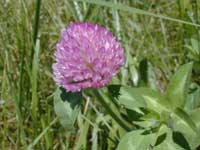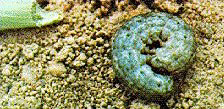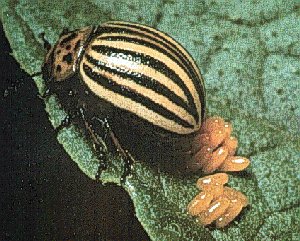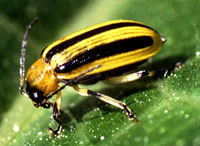

 Powdery mildew is the most serious disease of red clover in
the U.S. Growth of the powdery mildew fungus on leaves
gives them a whitish, powdery appearance. If disease
development is severe, leaflets turn yellow and then brown,
and they finally die. The disease has not been shown to
reduce yield but can reduce forage quality.
Powdery mildew is the most serious disease of red clover in
the U.S. Growth of the powdery mildew fungus on leaves
gives them a whitish, powdery appearance. If disease
development is severe, leaflets turn yellow and then brown,
and they finally die. The disease has not been shown to
reduce yield but can reduce forage quality.
In recent years, powdery mildew has been more serious on red clover in Kentucky than previously. A region-wide increase in the severity of a plant disease can be due to a variety of factors: enhanced overwintering from mild winters, weather during the growing season which is more favorable for disease development, etc. Tests were conducted at UK recently to attempt to sort out some of these factors. Seeds of a series of varieties were planted in the greenhouse and exposed to natural airborne spores of Erysiphe polygoni, a standard way to evaluate red clover reaction to powdery mildew. Plants exhibiting powdery mildew were counted. The results are presented in the table below.
These data show a surprisingly high incidence of powdery mildew on many entries. In particular, entries that have been known for very good to excellent resistance to powdery mildew, such as Kenland and Marathon (a Wisconsin variety), exhibited rather high levels of the disease. This suggests that the powdery mildew fungus has increased in virulence on red clover. This means that prevalent strains of E. polygoni are more able to cause disease than strains that predominated previously, at least on varieties with partial resistance.
The most important management option available for this disease is to select resistant varieties. As can be seen in these data, all varieties can be expected to develop some powdery mildew, but it would be wise to select varieties with partial resistance such as 'Freedom!' than a fully susceptible variety, such as a common red clover. Breeding is underway to increase the resistance of 'Freedom!'. Timely cutting may also help slightly by reducing quality losses by capturing forage before the disease has fully developed.
| Variety | % seedlings with powdery mildew |
|---|---|
| Marathon breeder seed | 55 de |
| Marathon certified | 41 fg |
| Marathon MR | 28 gh |
| WI-1 MR | 19 h |
| Lakeland breeder seed | 44 ef |
| Freedom! | 94 ab |
| Kenland | 100 a |
| KVMRS | 86 a |
| KY tetraploid | 79 c |
| Freedom! MR | 59 d |
| Common A | 100 a |
| Common B | 100 a |


During this week (# 15) in the 2001 outbreak year we saw the largest armyworm moth flights of the spring as measured by pheromone baited traps. However, in 2003 we see a fall in moth numbers from the 14th to 15th weeks.
The trap counts recorded today (week 15) on the UK-REC were 7 and 15 (average of 11) down from 1 and 60, (average of 30), for week 14. If you look at the five year average capture you will see that it is about 120 for week 15. If you check the data for 2001 (the outbreak year) you will find that week 15 represents the peak catch date with captures of 398 & 28 (average of 213). It appears this week's captures are well below both of those marks.
However, remember the Degree Days (DDs). During the outbreak of 2001 peak moth capture occurred on April 13th (week 15), when 302 DDs had accumulated. Currently (April 11, week 15) 292 DDs have accumulated. The current DD total is a little behind the outbreak year but not by much.
It does not appear that a major outbreak of True armyworms is in the making. However, we must consider that the cold, wet and windy snap of this past week may have suppressed the trap capture, and that the moths are still around and holed up in a protected place. This insect certainly bears watching over the next several weeks.
See "Insect Management Recommendations" for more wheat pest information.
 Grapes are becoming an important fruit crop in Kentucky
due to increases in grapes planted for wine production in
recent years. Many of the grapes planted a few years ago
will be coming into substantial production for the first time
this year. Grape buds have broken and new growth is
emerging from the vines.
Grapes are becoming an important fruit crop in Kentucky
due to increases in grapes planted for wine production in
recent years. Many of the grapes planted a few years ago
will be coming into substantial production for the first time
this year. Grape buds have broken and new growth is
emerging from the vines.
Disease management in spring between bud break and bloom is critical to growers aspiring to produce a harvestable crop. There are several diseases that are active now even though the symptoms developing from current infections won't be seen for several weeks or months.
--Black rot - Guignardia bidwellii. This is the most common foliar and fruit disease of grape in Kentucky. Most cultivars are susceptible to black rot. Management requires sanitation and proper fungicide selection and application.
--Powdery mildew - Uncinula necator. Most grapes are fairly susceptible to powdery mildew. Management requires proper fungicide selection and application.
--Downy mildew - Plasmopara viticola. Downy mildew is favored by cool, moist weather and can rapidly devastate a grape planting. Management requires proper fungicide selection and application.
--Cane and leaf spot - Phomopsis viticola. Management requires sanitation, cultivar selection, and proper fungicide selection and application.
Last year, wet periods in late April and early May were very favorable for black rot and Phomopsis cane and leaf spot and these diseases became devastating in some vineyards. Downy mildew and powdery mildew were less of a problem. Growers should concentrate on managing black rot and cane and leaf spot. Now that grape buds have broken, infections will occur just about any time there is more rain.
Black rot is the most problematic disease here so management strategies should emphasize black rot prevention. Because the pathogen is present almost every year in Kentucky and thrives under the warm humid weather which typifies our summers, it is very difficult to avoid. Except in very unusual circumstances, use of fungicides is almost always necessary to avoid heavy losses. Management requires an integrated approach involving cultural practices and chemical controls.
--Cultural practices to reduce black rot. Keep the foliage dry and less prone to disease by use of intelligent field site selection, training systems that ventilate the leaves, judicious nitrogen use, and appropriate irrigation practices. Plant disease-free plants and choose cultivars that resist diseases. Although most grape varieties are susceptible to black rot, a few such as Cascade, Cayuga White, Chancellor, Chelois, Cynthiana/Norton, DeChaunac, Elvira, Ives, Vidal 256, and Vignoles are less susceptible. Use good sanitation by removing and destroying diseased and dead wood, and mummies from the vine and on the ground.
--Fungicides for disease control. Leaf wetness requirements for black rot infections have been worked out. Fungicide sprays can be timed to coincide only with actual infection periods. However, even chemical controls need to be integrated because there are other fungal diseases in addition to black rot that need managing. For black rot, growers can choose protectant fungicides such as mancozeb (Dithane M-45, Manzate 200, Penncozeb), Captan, or Ziram. For greater effectiveness and some eradicant activity, these protectant fungicides can be mixed with fungicides such as Bayleton, Elite, Nova, Procure, or Rubigan. Strobilurin fungicides such as Abound, Flint, and Sovran can also be used.
More complete information about varietal susceptibility and timing and materials for grape disease control can be found in ID-94 Kentucky Commercial Small Fruit & Grape Spray Guide, available at County Extension Offices.
 With bloom finishing in some parts of the state, growers
should have their pheromone traps in place for San Jose
scale and codling moth. Ideally, we would like to have these
traps in place by the pink stage, but there still is a little time
to hang them. I like to have the codling moth trap set on the
second row from the outside of the orchard, at least half way
up in the tree, and on the southwest corner. The San Jose
scale trap should be placed on a tree that is known to have
an active scale infestation (scale on the fruit last season or
active scale noted while pruning). Both of these traps will
help to determine the need for and the timing of insecticide
applications.
With bloom finishing in some parts of the state, growers
should have their pheromone traps in place for San Jose
scale and codling moth. Ideally, we would like to have these
traps in place by the pink stage, but there still is a little time
to hang them. I like to have the codling moth trap set on the
second row from the outside of the orchard, at least half way
up in the tree, and on the southwest corner. The San Jose
scale trap should be placed on a tree that is known to have
an active scale infestation (scale on the fruit last season or
active scale noted while pruning). Both of these traps will
help to determine the need for and the timing of insecticide
applications.
For codling moth, the day the fifth moth is captured in the trap is the start of degree day counting. Minimum and maximum temperature are then used to calculate daily degree day values. Essentially, the average daily temperature minus 50NF is the daily degree day value. If the number is less than zero, then just use zero. When 250 of the degree day units have been recorded, then an insecticide is used for codling moth control. If more than ten moths were captured within a week, a second spray in used in the next cover spray.
With San Jose scale, the same method is used once the minute male scale are capture in the trap. Degree days for this pest are calculated using a base temperature of 51NF and a spray is applied at 405 degree days. San Jose scale has become much more of a problem in the past several years.
Early in the season it is important to get the seedlings and vegetable transplants off to a good start. There are a few early season insects that need to be managed to ensure healthy stands.
--Cole crops (Cabbage, Broccoli, Cauliflower) Striped flea beetles, imported cabbageworm and
diamondback moth larvae are the pests that attack the
spring crop. With flea beetles on seedling plants, less than 4
to 5 true leaves, use a threshold of an average of two beetles
per plant when deciding whether or not to spray. A
threshold of 15 percent infested plants can be used with
worms until either head-fill or crown formation, then the
threshold drops to 5 percent infested plants. While the type
of mixture of worms it is not important when deciding if to
spray, the types of worms will determine which insecticides
are used.
Striped flea beetles, imported cabbageworm and
diamondback moth larvae are the pests that attack the
spring crop. With flea beetles on seedling plants, less than 4
to 5 true leaves, use a threshold of an average of two beetles
per plant when deciding whether or not to spray. A
threshold of 15 percent infested plants can be used with
worms until either head-fill or crown formation, then the
threshold drops to 5 percent infested plants. While the type
of mixture of worms it is not important when deciding if to
spray, the types of worms will determine which insecticides
are used.
--Sweet Corn Corn flea beetles and cutworms are the two primary pests
that will attack seedling corn. Use 3 percent cut plants with
cutworms actively feeding as the guideline for treating
cutworms. Flea beetles can transmit the bacterium that
causes Stewart's Wilt, so wilt resistant cultivars may be
needed in years following mild winters. Fortunately, we
did NOT have a mild winter, so this threat is reduced. If
corn flea beetle is common, use a 50 percent of the plants
with leaf scars and some leaves turning white as the
threshold for spray decisions.
Corn flea beetles and cutworms are the two primary pests
that will attack seedling corn. Use 3 percent cut plants with
cutworms actively feeding as the guideline for treating
cutworms. Flea beetles can transmit the bacterium that
causes Stewart's Wilt, so wilt resistant cultivars may be
needed in years following mild winters. Fortunately, we
did NOT have a mild winter, so this threat is reduced. If
corn flea beetle is common, use a 50 percent of the plants
with leaf scars and some leaves turning white as the
threshold for spray decisions.
--Tomatoes and Peppers
Tobacco and potato flea beetles will attack both tomato and
pepper plants. Usually, the plants will quickly outgrow
moderate damage. Occasionally, serious damage can occur
to plants less than six inches. Use 4or more beetles per plant
and plants less than 6 inches as the guideline for treatment.
Colorado potato beetle can also do serious damage to
tomato plants less than 8 inches. Use 10 beetles per 20
plants as the guideline for treatment when the plants are
less than 8 inches.
--Eggplant and Potato As with tomato, flea beetles and Colorado potato beetle are
serious early season pests of potato and eggplant. Use the
same threshold for tomatoes above. Resistant to insecticides
continues to be a serious problem for Colorado potato
beetle. Because of this, producers should not use
insecticides with the same mode of action for consecutive
generations of this insect. Often local populations of this
insect may be resistant to one group of insecticides, and in
other areas they may be resistant to others. For this reason,
what works well in one county may not work at all in
another.
As with tomato, flea beetles and Colorado potato beetle are
serious early season pests of potato and eggplant. Use the
same threshold for tomatoes above. Resistant to insecticides
continues to be a serious problem for Colorado potato
beetle. Because of this, producers should not use
insecticides with the same mode of action for consecutive
generations of this insect. Often local populations of this
insect may be resistant to one group of insecticides, and in
other areas they may be resistant to others. For this reason,
what works well in one county may not work at all in
another.
--Squashes, Cucumbers and Melons Striped and spotted cucumber beetles can attack cucurbit
crops anytime after seedling or transplanting. Cucumber
beetles also transmit the bacterium that causes bacterial
wilt. For this reason, cucurbuit crops must be treated for
cucumber beetles as soon as they are planted. With
bacterial wilt susceptible crops, cucumber beetles need to
be effectively controlled through the start of flowering.
Keep in mind that cucurbits are insect pollinated, so
measures need to be taken to control the beetles and avoid
hurting pollinators. One method to avoid injuring
pollinators during bloom is to spray in the early evening
after pollinators have quit. The flowers that are open will be
closed the next day and new blooms free of insecticide on
the inner surface will be open the following day. Squash
bug is now known to persistently transmit the agent that
causes yellow vine. Therefore, we need to preventively
treat for squash bug as we do for cucumber beetles.
Striped and spotted cucumber beetles can attack cucurbit
crops anytime after seedling or transplanting. Cucumber
beetles also transmit the bacterium that causes bacterial
wilt. For this reason, cucurbuit crops must be treated for
cucumber beetles as soon as they are planted. With
bacterial wilt susceptible crops, cucumber beetles need to
be effectively controlled through the start of flowering.
Keep in mind that cucurbits are insect pollinated, so
measures need to be taken to control the beetles and avoid
hurting pollinators. One method to avoid injuring
pollinators during bloom is to spray in the early evening
after pollinators have quit. The flowers that are open will be
closed the next day and new blooms free of insecticide on
the inner surface will be open the following day. Squash
bug is now known to persistently transmit the agent that
causes yellow vine. Therefore, we need to preventively
treat for squash bug as we do for cucumber beetles.

UKREC-Princeton, KY, April 4 - 11| Black cutworm
| 0
| True armyworm
| 11
| | |
NOTE: Trade names are used to simplify the information presented in this newsletter. No endorsement by the Cooperative Extension Service is intended, nor is criticism implied of similar products that are not named.
Lee Townsend
Extension Entomologist